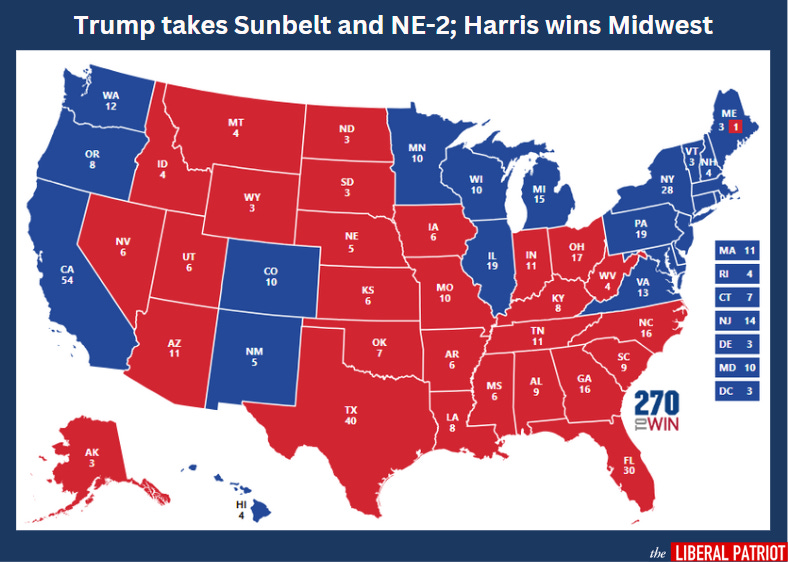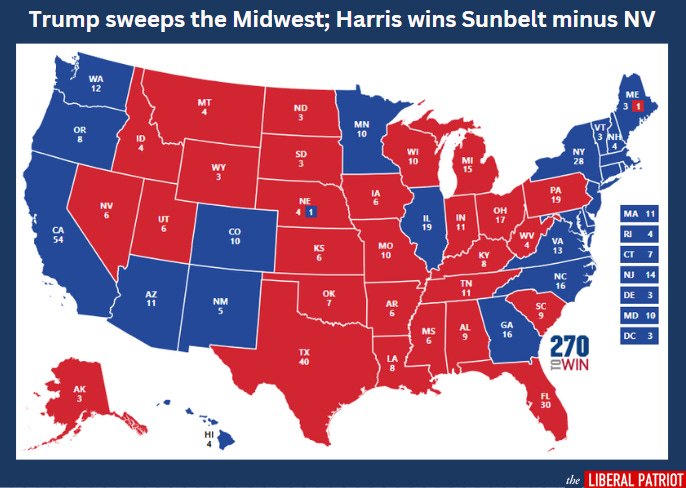An Electoral College Tie Would Be a Win for Trump
Looking at some "what-if" scenarios with 45 days to go.
Over the next 45 days, a tiny fraction of undecided voters across seven swing states (and one swing district) will decide the presidential election. It remains plausible that either candidate could win any mix of the seven. Within these combinations are several potential 269-269 Electoral College ties—an outcome not seen in two centuries.
What might a tied electoral map look like? Would Trump or Harris have the advantage if the election were sent to the House?
Let’s take a look at three plausible (if still unlikely) tied scenarios.
Scenario One
The “Blue Wall” holds for Harris, but Trump sweeps the four Sunbelt States and ekes out a win in Nebraska’s 2nd congressional district.
Scenario Two
Trump flips Michigan, Pennsylvania, and Georgia. Harris holds Wisconsin by the narrowest of margins—it’s where she’s polling the best today—and wins Nevada, Arizona, and North Carolina.
Scenario Three
A near inverse of the first scenario, Trump outperforms polling in the Midwest and sweeps the “Blue Wall” à la 2016, but Harris keeps Arizona, Georgia, and flips North Carolina.
Ultimate Scenario: The House Determines the Winner
If one of these scenarios proves correct, the contest would head to the House of Representatives where each state’s delegation (in the next Congress not the current one) receives one vote. In this “contingent election” scenario, Donald Trump would be an overwhelming favorite.
Why? Republicans safely hold 24 delegations and another pair, Iowa and Montana, lean their direction. So if Republicans hold steady, they should comfortably hit 26 votes—enough to send Donald Trump to the White House. In other words, Democrats need a clean sweep of House tossups and a few upsets just to get within striking distance. Let’s examine some of those closely divided states.
Alaska: Democrat Mary Peltola faces a fierce challenge from Republican Nick Begich. With one at-large congressional district, whoever wins will control the state’s vote.
Arizona: Republicans currently hold a 6-3 majority, but two of their seats are tossups—Juan Ciscomani’s AZ-6 and Dave Schweikert’s AZ-1. If Democrats can flip both, they would win a majority.
Colorado: Democrats have a 5-3 advantage, but freshman Rep. Yadira Caraveo represents a Biden +5 district north of Denver that Republicans hope to flip this year. A 4-4 split is the best the GOP can hope for as Colorado continues to move left.
Maine: Democrats have a 2-0 advantage heading into November. Republicans, however, hope to defeat Blue Dog Jared Golden and force a split.
Michigan: Democrats took a 7-6 lead after a neutral redistricting amendment took effect in 2022. But Dan Kildee in MI-8 and the open seat (vacated by Elissa Slotkin) in MI-7 are both at risk of flipping red. Democrats do have an offensive opportunity in the 10th District.
Minnesota: The current 4-4 split looks likely to hold barring a Republican upset of Angie Craig in the Minneapolis suburbs.
Pennsylvania: A 9-8 Democratic advantage is erased if either Susan Wild or Matt Cartwright is defeated in November. Both races are pure tossups at this point.
It is incredibly difficult to imagine Democrats winning a majority of state delegations. Just about everything would have to go their way—in which case Kamala Harris has likely won anyway.
So, as the election comes down to the wire, remember that in all likelihood Donald Trump’s magic number is 269—not 270.








There won't be a tie. That is Democrat hopium. Trump is solidly now (2 point) ahead in PA, which means in reality he is ahead more than that as he ALWAYS underpolls by 2.1 across two previous elections. He is ahead in 3/4 most recent MI polls---again, the under polling means this is pretty safe. We have run county by county analysis of WI, and Trump will carry that by minimum 40,000, max maybe 4 points. This means that Trump is way over 279. We will know more about NV soon, but the most recent early ballot #s in NC, Duval Co., FL, PA and GA show that Democrat early ballot requests are down 80 to 90% from 2020 (Biden carried these by 60%) and early vote constituted 2/3 of all votes, so it's safe to say that the Democrat vote in this area will be down massively, perhaps in the range of 5-7 million nationally. Moreover, the return rate of those early ballots---while still a majority D ballots---have a higher margin of Rs and lower margin of Ds than 2020, meaning that 5-7 million might be a conservative estimate.
Trump won't win New York, but the very fact that yesterday a poll came out with him UP .03 in NY is shocking. It means, yes, NJ is in play and that Harris will do well to get better than 10 in NY.
All of these indicators mean that the traditionally blue states of MN, VA, ME are all in play and on the table. Recent steam broilers union unofficial endorsement of Trump, the non-endorsement (but real) endorsement of Trump by the Teamsters, and the heavy support he is getting from the culinary union all suggest that every single pollster is UNDERESTIMATING his strength even more.
Last example: With the so-called "81 million votes" in 2020, Biden won AZ by 11,000. At that time AZ was R+130,000 registrations statewide. Today, JUST in Maricopa Co. and Yavapai Co., after massive shifts, Rs are +200,000 just in those two counties. My estimate is that AZ will be R+400,000 on election day, FL will be R+very close to 1 MILLION on election day. NC will be under 150,000 D (Trump won 2x with double that numbers of Ds).
So a reality needs to sink in that whatever garbage the polls are humping out, it's nowhere close to the actual, measurable, REAL evidence on the ground. This will be a 2016 shock, only worse.
The United States cannot remain even a partial democracy if we do not get rid of the Electoral College. And yet doing that requires the near impossible: either a Constitutional Amendment (zero chance of that ever passing in today's polarized country), or else more states agreeing to commit their EC representatives to vote however the national vote total goes. Why would any swing state ever agree to that?